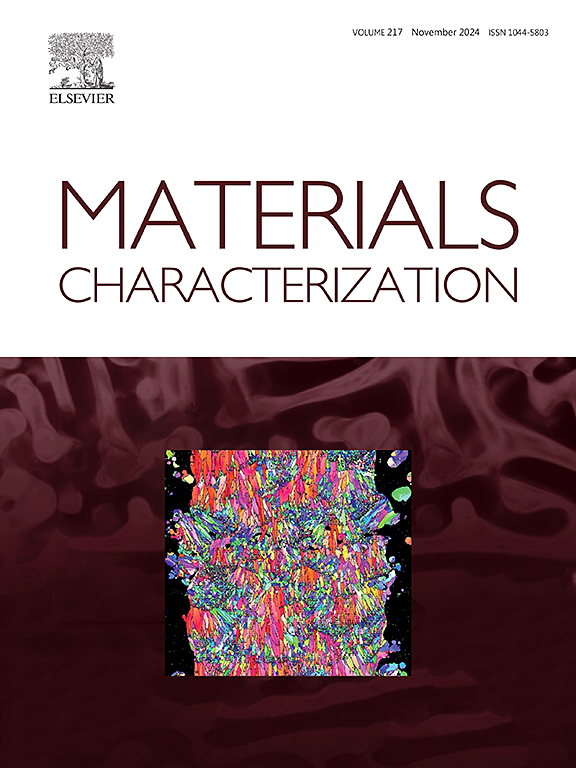脉冲冷金属转移焊高速钢冷轧辊修复层的组织、性能及磨损特性
IF 5.5
2区 材料科学
Q1 MATERIALS SCIENCE, CHARACTERIZATION & TESTING
引用次数: 0
摘要
冷轧辊在恶劣的条件下工作,这可能导致表面损坏。修复损坏的滚筒是一种经济有效的解决方案,可显著延长其使用寿命。采用传统的气体保护金属弧焊(GMAW)修复时,基材出现了严重的热变形和广泛的热影响区(HAZ)。GMAW修复层晶粒粗大,力学性能差。与传统的GMAW相比,脉冲冷金属转移焊(CMT-P)由于其更低的热输入和增强的熔池搅拌,显著降低了基体变形、热影响区宽度和晶粒尺寸,从而使修复层具有更好的磨损和弯曲性能。焊态修复层组织由针状马氏体和残余奥氏体组成。为了进一步优化修复层的组织和力学性能,对修复层进行了回火处理。500℃回火2h后,RA转变为新的马氏体,碳化物析出相均匀地出现在马氏体基体内。在这种情况下,修复层的硬度达到61.8 HRC,高于滚柱基体工作层的硬度(60.1 HRC)。此外,修复层具有较低的摩擦系数和磨损体积,具有优异的耐磨性。此外,修复层具有优异的抗弯性能,抗弯强度为1912.7 MPa,挠度为2.89 mm。本文章由计算机程序翻译,如有差异,请以英文原文为准。

Microstructure, properties and wear characteristics of high-speed steel cold roller repair layers via pulse cold metal transfer welding
The cold roller operates under harsh conditions, which can lead to surface damage. Repairing damaged rollers is a cost-effective solution that significantly extends their service life. The substrate developed severe thermal deformation and a wide heat-affected zone (HAZ) when repaired using traditional gas metal arc welding (GMAW). Moreover, the GMAW repair layers had coarse grains and poor mechanical properties. Compared with conventional GMAW, pulse cold metal transfer welding (CMT-P) significantly reduced substrate deformation, HAZ width, and grain size due to its lower heat input and enhanced molten pool agitation, resulting in superior wear and bending properties of the repaired layers. The microstructure of the as-welded repair layers consisted of acicular martensite and retained austenite (RA). To further optimize the microstructure and mechanical properties of the repair layers, tempering treatment was conducted. After tempering at 500 °C for 2 h, the RA transformed into fresh martensite, and the carbide precipitates appeared uniformly within the martensite matrix. In this case, the hardness of the repair layers reached 61.8 HRC, which was higher than that of the roller matrix working layer (60.1 HRC). Furthermore, the repair layers exhibited lower friction coefficients and wear volumes, achieving superior wear resistance. Additionally, the repaired layers exhibited excellent bending properties, demonstrating a bending strength of 1912.7 MPa and deflection of 2.89 mm.
求助全文
通过发布文献求助,成功后即可免费获取论文全文。
去求助
来源期刊

Materials Characterization
工程技术-材料科学:表征与测试
CiteScore
7.60
自引率
8.50%
发文量
746
审稿时长
36 days
期刊介绍:
Materials Characterization features original articles and state-of-the-art reviews on theoretical and practical aspects of the structure and behaviour of materials.
The Journal focuses on all characterization techniques, including all forms of microscopy (light, electron, acoustic, etc.,) and analysis (especially microanalysis and surface analytical techniques). Developments in both this wide range of techniques and their application to the quantification of the microstructure of materials are essential facets of the Journal.
The Journal provides the Materials Scientist/Engineer with up-to-date information on many types of materials with an underlying theme of explaining the behavior of materials using novel approaches. Materials covered by the journal include:
Metals & Alloys
Ceramics
Nanomaterials
Biomedical materials
Optical materials
Composites
Natural Materials.
 求助内容:
求助内容: 应助结果提醒方式:
应助结果提醒方式:


